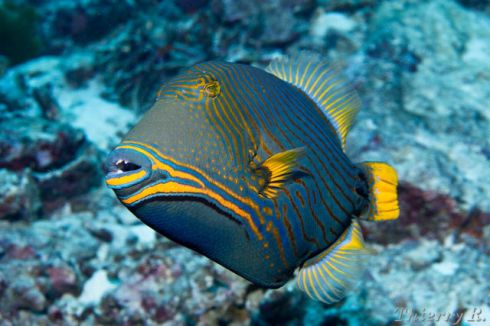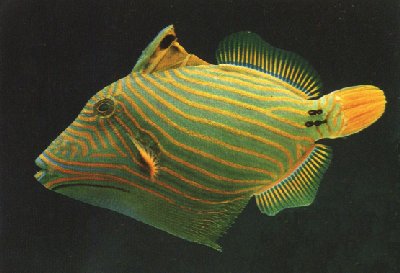Today we bask in the tropical glory of a brilliantly colored (albeit temperamental) fish from my favorite family of fish, the Balistidae. This is the orange-lined triggerfish (Balistapus undulates). This aggressive reef fish is the only member of its genus (possibly because it attacked and destroyed all of its relatives). It lives throughout the tropical waters of the Indo-Pacific with all manner of horrifying sharks, marine crocodiles, and fishing humans, but it seems to care little and is noted not just for its extravagant color but also for its brash highly territorial character.
The orange-lined triggerfish is an omnivore. It mostly eats invertebrates such as mollusks, sponges, echinoderms, and corals (the fish crunches off the rocklike coral tips with its fearsome beak—which it also uses to bite through mollusk shells) but, when the opportunity arises it also eats marine algae and other fish. When it takes bites out of divers it is probably defending its territory and not expanding its diet. Triggerfish have eyes which move independently of each other so they can keep track of everything going on in their lively reef habitats. For the same reason, they have excellent color vision. They are long-lived and clever. Different individuals have different personalities and habits.
The fish is green with brilliant orange stripes and orange/yellow translucent fins. It grows to 30 centimeters (1 foot) long. Like other triggerfish, it has a powerful erectile spine in its dorsal fin. This spine lies in a groove in the fish’s body but can be locked in place when the fish is threatened. If the fish is in open water this means that a predator must swallow a nasty spike, but if the triggerfish is near coral or rocks (which it nearly always is) it can wedge itself beneath and then lock itself inextricably in place. A predator must try to pull the triggerfish out while contending with the sharp beak.





Leave a comment
Comments feed for this article